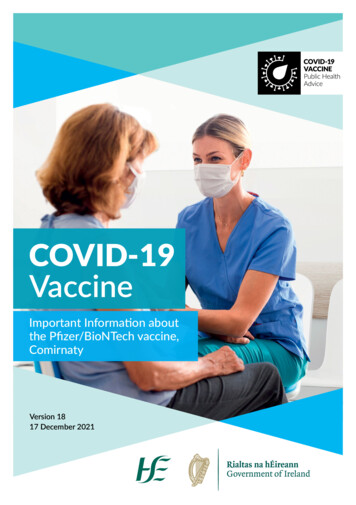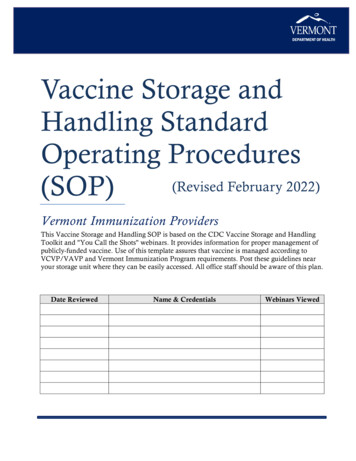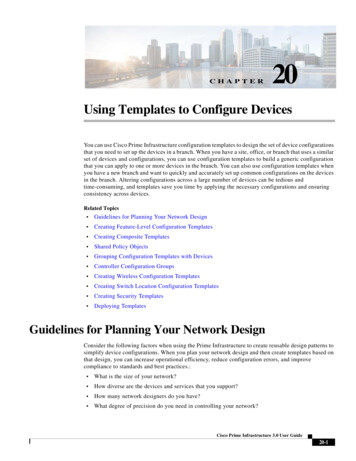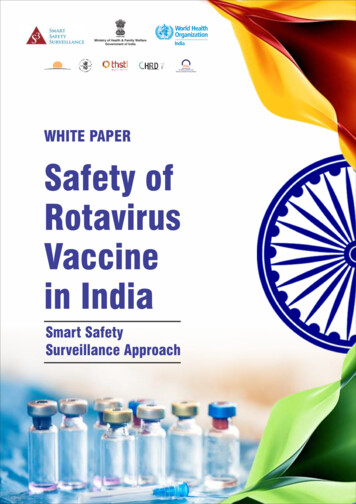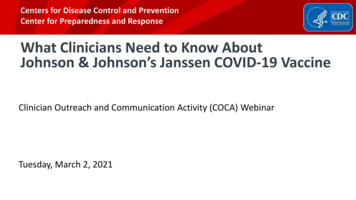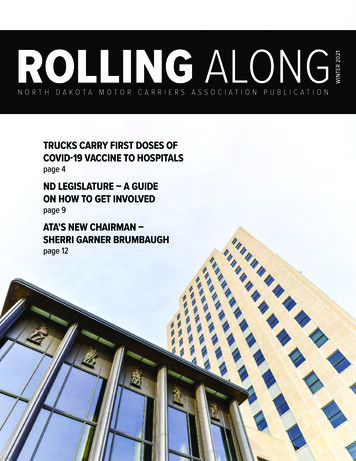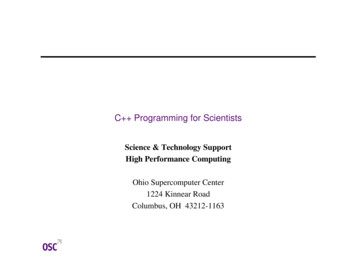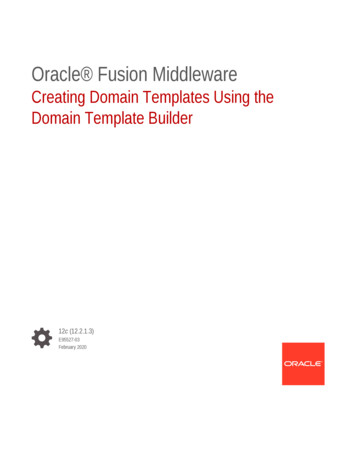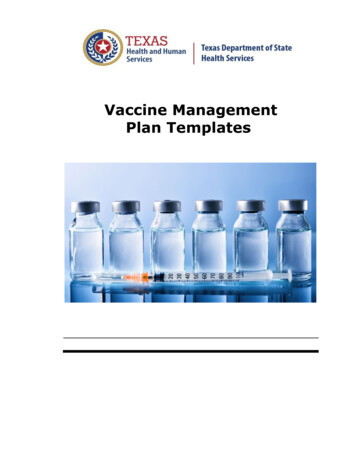
Transcription
Vaccine ManagementPlan Templates
Table of ContentsContact List . 3DSHS Immunization Routine Vaccine Storage and Handling Plan . 5Procedures for Routine Vaccine Storage and Handling of Vaccine . 7Emergency Vaccine Storage and Handling Plan . 15Procedures for Emergency Vaccine Storage and Handling of Vaccine. 15Emergency Vaccine Storage and Handling Plan Checklist:Refrigerated Vaccine . 17Emergency Vaccine Storage and Handling Plan Checklist:Frozen Vaccine . 19VaxiPac Resources 231 Pa g e
THIS PAGE INTENTIONALLY LEFT BLANK2 Pa g e
Contact ListVaccine CoordinatorsVaccine Coordinators Phone Number(Name/Title)(home, cell)AlternatePhone Number(home, cell)Email AddressPrimary:Secondary:Alternate (back-up):Resources Contact ListResourcesPhone NumberEmail AddressLocal HealthDepartment (LHD)DSHS Public HealthRegion (PHR)DSHS ImmunizationDisaster ResponseAdditional Resourcesimmdro@dshs.texas.govCompany /Entity NamePhone NumberEmail AddressElectric/Power/Utility CompanyRefrigerator repairFreezer repairData loggerrepair/recalibration3 Pa g e
THIS PAGE INTENTIONALLY LEFT BLANK4 Pa g e
Texas DSHS ImmunizationRoutine Vaccine Storage and Handling PlanInstructions: All Texas DSHS Immunization enrolled sites areresponsible for routine management of vaccine inventory. Oncecompleted, this template will serve as the required RoutineVaccine Storage and Handling Plan.This plan should be reviewed annually or whenever there arechanges to the signing clinician, vaccine coordinators, or vaccinestorage equipment. The most current Routine Vaccine Storage andHandling Plan will be reviewed during Texas DSHS ImmunizationProgram Compliance Site Visits (if applicable).A copy of this plan, along with the Emergency VaccineStorage and Handling Plan, must be posted on or near allrefrigerators and freezers that store vaccine.Clinic Name:Clinic Address:PIN:Email Address:Telephone number:Fax Number:Signing Clinician or Equivalent:Primary Vaccine Coordinator:Back-up Vaccine Coordinator:Alternate Back-up:Person(s) Responsible for MonthlyVaccine Count:Person Responsible for MonthlyVaccine Reporting and Ordering:Person Responsible for RotatingVaccine Inventory:Person Responsible for Receivingand Storing Vaccine Shipments:Routine Vaccine Storage and Handling Plan reviewed and updated by:Name:Title:Signature:Date of Last Review:5 Pa g e
THIS PAGE INTENTIONALLY LEFT BLANK6 Pa g e
Texas DSHS ImmunizationProcedures for Routine Storage and Handling of VaccineTemperature Monitoring is responsible for monitoring datalogger(s) and recording temperatures of all vaccine storageunits.In their absence,is responsible formonitoring and recording temperatures. A Temperature Recording Form (stock no. EC-105) must beposted on or near all units storing vaccine. Current refrigerator/freezer temperatures must be recordedtwice daily on the Temperature Recording Form (stock no.EC-105). Staff are required to record min/max temperatures at least oncedaily, preferably in the morning. Results of each temperature check must be documented on theTemperature Recording Form (stock no. EC-105). The time(hour and minute) and the initials of the staff membermonitoring/recording the information must be documented onthe form. Do not round the temperatures up or down – record only thenumber to the left of the decimal point. If an out-of-range temperature is observed, immediately contactyour Responsible Entity (RE) (DSHS LHD or PHR) and completethe “Vaccine Storage Troubleshooting Record” on page 3 of theTemperature Recording Form (stock no. EC-105).Vaccine Storage Clinics enrolled in the Texas DSHS Immunization Program arerequired to have the appropriate equipment to store vaccinethat will maintain proper temperatures. Refrigerator/freezer units must be large enough to hold DSHSand private vaccine during back-to-school or flu seasonwithout crowding.7 Pa g e
In order of preference, DSHS recommends the use of a:1) pharmaceutical, purpose-built unit,2) stand-alone refrigerator and stand-alone freezer, or3) household combination unit, using only the refrigeratorsection unless the refrigerator and freezer compartments haveseparate thermostat controls (they must have separateexterior doors). A stand-alone freezer must be used whenusing a combination unit for refrigerated vaccine. Small combination refrigerator-freezer units outfitted with a singleexternal door (dorm-style) are never allowed for the storage ofvaccine. The refrigerator compartment must maintain temperaturesbetween 36 F and 46 F (2 C and 8 C) for vaccine viability. The freezer compartment must maintain temperatures between-58 F and 5 F (-50 C and -15 C). Place water bottles (labeled “Do Not Drink”) on the top shelf,under the cold air vent, on the floor of the unit, in the door, alongboth sides of the walls, and at the back of the refrigerator.o Water bottles are not recommended for certainpharmaceutical and purpose-built units. Follow themanufacturer’s guidance in those instances. Place frozen water bottles along both sides of the walls, at theback, on the floor, and in the door of the freezer. The ultra-cold freezer must maintain temperatures between-112 F and -76 F (-80 C and -60 C). Diluents that are not packaged with vaccine may be storedoutside of the storage unit or in the door of the refrigerator.DONOT freeze diluent. Do not store food or drinks in the same refrigerator or freezer asvaccine. Do not store lab specimens on the same shelf or above vaccine.Store specimens below vaccine or in a separate storage unit. Refrigerators and freezers storing vaccine must be pluggeddirectly into a wall outlet with a plug guard installed. Multi-stripoutlets are not allowed.Vaccine Shipping and Receiving Procedures8 Pa g e
is responsible for receiving and storingvaccine shipments. In their absence,isresponsible for receiving and storing vaccine shipments.9 Pa g e
Staff must ensure that an accurate shipping address and deliveryhours are entered into the Vaccine Allocation Ordering System(VAOS) or Electronic Vaccine Inventory (EVI) system. Staff must always accept vaccine shipments in a timely manner.Never refuse or return vaccine shipments without specificinstructions from DSHS. Texas DSHS Immunization Unit recommends all sites have aprotocol to ensure the vaccine is stored immediately andappropriately upon arrival. The following steps must be takenwhen a vaccine shipment arrives:o Check the vaccine received against the packing list to verifyall vaccines have been received.o Verify the packing list against the order placed in VAOS/EVIonce the vaccine has been properly stored. Receive theorder in VAOS/EVI.o Ensure adequate diluent is included for vaccines requiringreconstitution. IMMEDIATELY contact the DSHS if vaccine or diluent wasordered and not received.o Place vaccine in the appropriate storage unit immediately.o Ensure vaccines with longer expiration dates are storedbehind shorter-dated vaccines. This ensures short-datedvaccine is used first.o If the data logger or temperature monitoring strip in thepackage indicates or if staff suspect that the cold chain hasbeen compromised, staff should immediately: Place the back-up data logger probe in the shipment,near the vaccine, and put the lid back on it, to gain thecurrent temperature. Check it frequently to see whenthe temperature stabilizes. Store questionable shipments appropriately, until officialword is received from vaccine distributor. If applicable, contact DSHS to inform of thetemperature excursion during shipping and the viabilitydetermination made by the manufacturer.10 P a ge
Vaccine Ordering Procedures is responsible for ordering vaccine. All vaccine orders are submitted in VAOS/EVI (unless internetaccess is unavailable). Staff are required to enter in VAOS/EVI all vaccines received,doses transferred, expired/wasted vaccine, doses administered,and a physical count of all DSHS vaccines in their inventory eachmonth regardless of whether an order is placed. Staff are responsible for contacting DSHS to update providerinformation, including delivery address, days and hoursavailable to receive vaccine shipments, and primary and backup contact information.Inventory Control including stock rotation is responsible for managing DSHSvaccine inventory. is responsible for reporting vaccinereceived, vaccine transferred, vaccine loss, and physical count inVAOS/EVI each month. Vaccine with the shortest expiration date must be used first. Staff should to notify DSHS 60-90 days prior to the vaccineexpiration date.Vaccine Loss (expired, spoiled, and wasted vaccine) Staff are required to follow the procedures listed below when avaccine loss occurs:ois responsible for completing andsubmitting the Vaccine Loss Report (VLR) in VAOS/EVI.o Separate expired/spoiled vaccine from the other vaccine inthe storage unit immediately. Label “DO NOT USE” and callthe manufacturer for further guidance. If instructed to discardthe vaccine, please follow all state and jurisdictional policiesfor waste management.11 P a g e
o Report every dose of vaccine that is wasted, spoiled, orexpired to the Texas DSHS Immunization Programelectronically in VAOS/EVI within four days of the incident.o The completed VLR must be printed and signed by the signingclinician who signed the Texas DSHS ImmunizationAgreement or a prescribing authority that is listed on theTexas DSHS Immunization Agreement. Staff are should to follow these procedures for returningexpired or spoiled vaccine:is responsible for returning expired orospoiled vaccine.o Complete the VLR as indicated above and submit to the DSHS.o Once the VLR is processed, your primary vaccinecoordinator will receive a shipping label via email.o Staff must ensure that all and only vaccines listed on that VLRare included in the box for return.o A copy of the VLR must be included in each box whenreturning expired or spoiled vaccine.o Shipping/Return labels expire after 30 days. If UPS has notpicked up the package within 30 days, another shipping labelmust be requested.o All opened multi-dose vials, broken vials, or syringes must bemarked through with a single line on the VLR and not includedin the box for return.o Do not return broken vials or syringes and do not returnsyringes with exposed needles.o You must wait until UPS returns to your office with the nextdelivery to return the box with the expired or spoiled vaccines;otherwise, charges may be incurred.12 P a g e
THIS PAGE INTENTIONALLY LEFT BLANK13 P a g e
Texas DSHS ImmunizationEmergency Vaccine Storage and Handling PlanInstructions: All Texas DSHS Immunization enrolled sites areresponsible for accurate management of their vaccine inventory inthe event of an emergency. Once completed, this template willserve as the recommended Emergency Vaccine Storage andHandling Plan.You should review and update this plan annually or more frequently ifthere are any changes to the plan, or changes in staff responsible forvaccine management, storage and handling. The most current EmergencyVaccine Storage and Handling Plan will be reviewed during DSHSImmunization Compliance Site Visits.A copy of this plan, along with the Routine Vaccine Storageand Handling Plan, must be posted on or near all refrigeratorsand freezers that store DSHS vaccine.Clinic Name:Clinic Address:COVID/TVFC/ASN PINPIN (if applicable):Telephone Number:Email Address:Signing Clinician or Equivalent:Primary Vaccine Coordinator:Back-up Vaccine Coordinator:Alternate Back-up:Person(s) Responsible for MonthlyVaccine Count:Person Responsible for VaccineMonthly Reporting and Ordering:Person Responsible for RotatingVaccine Inventory:Person Responsible for Receiving andstoring Vaccine Shipments:Fax Number:Emergency Vaccine Storage and Handling Plan reviewed and updated by:Name:Title:Signature:Date of Last Review:14 P a g e
Location vaccines will be transferred to in case of emergency:Location Name:Contact Person at ReceivingLocation:Address:Telephone Number:COVID/TVFC/ASN PIN(if applicable):Second Person at ReceivingLocation:Is there a Temperature Monitoringdevice for the Refrigerator andFreezer? YesNoIs there adequate space to store thevaccine during an emergency? YesNoIs there a generator? YesNoDate of Agreement:Emergency Vaccine Storage and Handling Plan reviewed and updated by:Name:Title:Signature:Date of Last Review:15 P a g e
Texas DSHS ImmunizationProcedures for Emergency Storageand Handling of Vaccine Identify a responsible person and a responsible back-up person whowill enact the Emergency Vaccine Storage and Handling Plan.Include contact information, such as home, office, and cell phonenumbers for each person.The person responsible for enacting the Emergency Vaccine Storageand Handling Plan is. The back-up personresponsible for enacting the Emergency Storage and Handling Planis. Identify an emergency contact and storage location to take theDSHS vaccine for storage. The emergency storage location musthave appropriate vaccine storage equipment capable ofmaintaining temperatures within acceptable ranges, as well asadequate space to accommodate the vaccine inventory at thebusiest time of the year (e.g. flu or back-to-school season)without crowding. Temperatures for storage units are required tobe monitored and recorded, per DSHS guidelines. A location with apower generator or other alternate source of power, such as ahospital or pharmacy is preferable. Contact the emergency storage location for their approval beforeincluding them on your plan. List the contact person(s) and phonenumber(s) on your plan. Consider locating a back-up location incase the primary emergency storage location is unavailable orunable to store vaccines. Using the emergency vaccine storage and handling plan checklistfor refrigerated and frozen vaccine:o Document the time the emergency/power outage occurs.o Document the temperature of the vaccine storage units beforeremoving any vaccine for transportation.o Review how refrigerated vaccine should be packed fortransport, and pack them using only approved storageunits.16 P a g e
o Insert a certified and calibrated data logger probe in the in thecenter of the vaccine storage unit, and note the timetemperature when the vaccine is placed in the storage unit.Before storing the vaccine inside of the receiving emergencystorage unit, document the temperature of that storage unit.o Conduct an inventory of the vaccine as you move it to thetransport container and record the information: Lot number, Number of doses of each vaccine, and Expiration datesYou must follow all guidance provided by DSHS when transferringvaccines in the event of an emergency.In the table below, provide the information where you will obtain thenecessary items for emergency transport of vaccine and theappropriate contact information. Do not use frozen gel packs or coolant packs fromvaccine shipments to pack refrigerated/frozen vaccines. Dry ice is only to be used to transport Pfizer COVID-19vaccine when in ultra-cold state. Do not use dry ice to keep normal freezer temperaturesfor any other vaccine, even if for temporary storage.Where to obtain:Phone number:Portable Refrigerator: (Optional)Portable Freezer: (Optional)Cooler(s):Frozen Water Bottles:Bubble-wrap / Corrugated cardboard:17 P a g e
VaxiPac w/Bricks:In the event of a citywide evacuation, contact DSHS for assistance.18 P a g e
Emergency Vaccine Storage and Handling Plan Checklist:Refrigerated VaccineContact with DSHS made prior to transport by:Date:Time:AMPMPerson Transporting Vaccine:Transport of REFRIGERATED VaccineAssemble packing supplies.Container used to transport refrigerated vaccines: Portable fridge CoolerOther supplies needed if using a cooler: Conditioned frozen water bottles* Certified, calibrated data logger Packing material (2” of bubble wrap or crumpled paper andtwo pieces of cardboard that is cut to cooler size)* Frozen water bottles that are not “conditioned” can freezevaccines. To “condition” frozen water bottles, remove themfrom the freezer and immerse in a sink of water or underrunning water until the ice spins freely in the bottle.Spread a layer of conditioned water bottles at the bottom ofthe cooler. Cover the conditioned water bottles with a piece ofcardboard, cut to the size of the cooler. Cover with a 2” layerof bubble wrap or crumpled paper.Stack vaccine boxes on the bubble wrap or crumpled paper.Vaccines must not touch the conditioned water bottles in thecooler.Place the data logger probe with vaccines.Cover the vaccine with 2’’ layer of bubble wrap or crumpledpaper. Add a piece of cardboard, cut to the size of the cooler.Add conditioned water bottles to cover the cardboard.Fill the cooler to the top with bubble wrap or crumpled paper.Place the data logger display on top of the bubble wrap,crumpled paper, or outside the cooler.19 P a g e
Emergency Vaccine Storage and Handling Plan Checklist:Refrigerated Vaccine (Continued)Contact with DSHS made prior to transport by:Date:Time:AMPMPerson Transporting Vaccine:Transport of REFRIGERATED Vaccine (Continued)Include a list of the vaccines that are in the container.Record temperatures on a Temperature Recording Form priorto transport.Temperature of storage unit when the vaccines are removed: C FTime vaccines were removed from storage unit: AM PMTemperature of transport container when the vaccines wereplaced inside: C FRecord temperatures on a Temperature Recording Form uponarrival at the emergency storage location.Temperature of transport container when the vaccines areremoved: C FTime vaccines were removed from transport container: AM PMTemperature of storage unit when the vaccines were placedinside: C F20 P a g e
Emergency Vaccine Storage and Handling Plan Checklist:Frozen VaccineContact with DSHS made prior to transport by:Date:Time:AMPMPerson Transporting Vaccine:Transport of FROZEN VaccineAssemble packing supplies.Container used to transport frozen vaccines: Portable freezer VaxiPac CoolerOther supplies needed if using a cooler: Frozen water bottles. Certified, calibrated data logger (to be used with VaxiPac too). Packing material (2” of bubble wrap/paper and twopieces of cardboard that is cut to the the cooler size).Do not freeze diluent during transportIf a cooler is used:Spread a layer of frozen water bottles on the bottom of thecooler. Cover the frozen water bottles with a piece of cardboard,cut to the size of the cooler, and a 2’’ layer of bubble wrap orcrumpled paper.Stack vaccine boxes on the bubble wrap or crumpled paper.Vaccines must not touch the frozen water bottles.Place the data logger probe with vaccines.Cover vaccine with 2’’ layer of bubble wrap or crumpled paper.Add a piece of cardboard, cut to the size of the cooler. Addfrozen water bottles to cover the cardboard.Fill the cooler to the top with bubble wrap or crumpled paper.Place the data logger display on top of the bubble wrap,crumpled paper, or outside the cooler.21 P a g e
Emergency Vaccine Storage and Handling Plan Checklist:Frozen Vaccine (Continued)Contact with DSHS made prior to transport by:Date:Time:AMPMPerson Transporting Vaccine:Transport of FROZEN Vaccine (Continued)If a VaxiPac is used:Pack vaccine in accordance with manufacturer instructions(place one freezer brick on the bottom, followed by vaccine andprobe, followed by four more freezer bricks).Include data logger probe with vaccines. Place the data loggerdisplay outside the VaxiPac .For all transport of frozen vaccine:Using a Vaccine Transfer Authorization Form (stock no. EC-67),include a list of the vaccines that are in the container.Record temperatures on a Temperature Recording Form(stock no. EC-105) prior to transport.Temperature of storage unit when the vaccines are removed: C FTime vaccines were removed from storage unit: AM PMTemperature of transport container when the vaccines wereplaced inside: C FRecord temperatures on a Temperature Recording Form (stockno. EC-105) upon arrival at the emergency storage location.Temperature of transport container when the vaccines areremoved: C FTime vaccines were removed from transport container: AM PMTemperature of emergency storage unit when the vaccineswere placed inside: C F22 P a g e
VaxiPac Vaccine TransportDo Not Use dry ice. Most manufacturers do not recommend transportingvaccines on dry ice as it may expose the vaccine to temperatures below-58 F.A VaxiPac is an approved method for transporting frozen vaccine thatdoes not short date the product. The VaxiPac can reliably maintain anaverage temperature between 5 F and -58 F when used with eitherVaxiSafe (-20 C) or VaxiSafe (-15 C) frozen bricks. Refer to theVaxiPac manual for specific instructions.If vaccine is not transported in a VaxiPac , then document EXPLICITLY:1) time storage began; 2) time storage ended; and 3) storagetemperatures under which the vaccine was kept for this period of time.The manufacturer should be called before discarding frozen vaccinethat has been kept under less than ideal storage conditions.Questions regarding Vaccine shipments or transport should be directedto the manufacturer.Resources:Web content- Microsoft Word - Varicella Web Guide 3 .doc (texas.gov), Photo - AcuTemp PX1L (pharmaceuticalonline.com)
Texas Department of State Health ServicesImmunization UnitRev. 6/2021
the event of an emergency. Once completed, this template will serve as the recommended Emergency Vaccine Storage and Handling Plan. You should review and update this plan annually or more frequently if there are any changes to the plan, or changes in staff responsible for vaccine management, storage and handling. The most current Emergency
